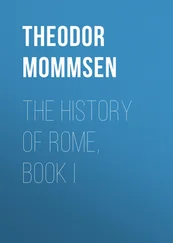Theodor Mommsen - The history of Rome
Здесь есть возможность читать онлайн «Theodor Mommsen - The history of Rome» весь текст электронной книги совершенно бесплатно (целиком полную версию без сокращений). В некоторых случаях можно слушать аудио, скачать через торрент в формате fb2 и присутствует краткое содержание. Жанр: История, Культурология, на английском языке. Описание произведения, (предисловие) а так же отзывы посетителей доступны на портале библиотеки ЛибКат.
- Название:The history of Rome
- Автор:
- Жанр:
- Год:неизвестен
- ISBN:нет данных
- Рейтинг книги:5 / 5. Голосов: 1
-
Избранное:Добавить в избранное
- Отзывы:
-
Ваша оценка:
- 100
- 1
- 2
- 3
- 4
- 5
The history of Rome: краткое содержание, описание и аннотация
Предлагаем к чтению аннотацию, описание, краткое содержание или предисловие (зависит от того, что написал сам автор книги «The history of Rome»). Если вы не нашли необходимую информацию о книге — напишите в комментариях, мы постараемся отыскать её.
The history of Rome — читать онлайн бесплатно полную книгу (весь текст) целиком
Ниже представлен текст книги, разбитый по страницам. Система сохранения места последней прочитанной страницы, позволяет с удобством читать онлайн бесплатно книгу «The history of Rome», без необходимости каждый раз заново искать на чём Вы остановились. Поставьте закладку, и сможете в любой момент перейти на страницу, на которой закончили чтение.
Интервал:
Закладка:
17.The account that large tracts on the coasts of the North Sea had been torn away by inundations, and that this had occasioned the migration of the Cimbri in a body (Strabo, vii. 293), does not indeed appear to us fabulous, as it seemed to those who recorded it; but whether it was based on tradition or on conjecture, cannot be decided.
18.III. VII. Measures Adopted to Check the Immigrations of the Transalpine Gauls.
19.IV. III. Modifications of the Penal Law.
20.The usual hypothesis, that the Tougeni and Tigorini had advanced at the same time with the Cimbri into Gaul, cannot be supported by Strabo (vii. 293), and is little in harmony with the separate part acted by the Helvetii. Our traditional accounts of this war are, besides, so fragmentary that, just as in the case of the Samnite wars, a connected historical narration can only lay claim to approximate accuracy.
21.To this, beyond doubt, the fragment of Diodorus (Vat. p. 122) relates.
22.IV. IV. The Proletariate and Equestrian Order under the Restoration.
23.The deposition from office of the proconsul Caepio, with which was combined the confiscation of his property (Liv. Ep. 67), was probably pronounced by the assembly of the people immediately after the battle of Arausio (6th October 649). That some time elapsed between the deposition and his proper downfall, is clearly shown by the proposal made in 650, and aimed at Caepio, that deposition from office should involve the forfeiture of a seat in the senate (Asconius in Cornel, p. 78). The fragments of Licinianus (p. 10; Cn. Manilius ob eandem causam quam et Caepio L. Saturnini rogatione e civitate est cito [?] eiectus ; which clears up the allusion in Cic. de Or. ii. 28, 125) now inform us that a law proposed by Lucius Appuleius Saturninus brought about this catastrophe. This is evidently no other than the Appuleian law as to the minuta maiestas of the Roman state (Cic. de Or. ii. 25, 107; 49, 201), or, as its tenor was already formerly explained (ii. p. 143 of the first edition [of the German]), the proposal of Saturninus for the appointment of an extraordinary commission to investigate the treasons that had taken place during the Cimbrian troubles. The commission of inquiry as to the gold of Tolosa (Cic. de N. D. iii. 30, 74) arose in quite a similar way out of the Appuleian law, as the special courts of inquiry - further mentioned in that passage - as to a scandalous bribery of judges out of the Mucian law of 613, as to the occurrences with the Vestals out of the Peducaean law of 641, and as to the Jugurthine war out of the Mamilian law of 644. A comparison of these cases also shows that in such special commissions - different in this respect from the ordinary ones - even punishments affecting life and limb might be and were inflicted. If elsewhere the tribune of the people, Gaius Norbanus, is named as the person who set agoing the proceedings against Caepio and was afterwards brought to trial for doing so (Cic. de Or. ii. 40, 167; 48, 199; 49, 200; Or. Part. 30, 105, et al.), this is not inconsistent with the view given above; for the proposal proceeded as usual from several tribunes of the people (ad Herenn. i. 14, 24; Cic. de Or. ii. 47, 197), and, as Saturninus was already dead when the aristocratic party was in a position to think of retaliation, they fastened on his colleague. As to the period of this second and final condemnation of Caepio, the usual very inconsiderate hypothesis, which places it in 659, ten years after the battle of Arausio, has been already rejected. It rests simply on the fact that Crassus when consul, consequently in 659, spoke in favour of Caepio (Cic. Brut. 44, 162); which, however, he manifestly did not as his advocate, but on the occasion when Norbanus was brought to account by Publius Sulpicius Rufus for his conduct toward Caepio in 659. Formerly the year 650 was assumed for this second accusation; now that we know that it originated from a proposal of Saturninus, we can only hesitate between 651, when he was tribune of the people for the first time (Plutarch, Mar. 14; Oros, v. 17; App. i. 28; Diodor. p. 608, 631), and 654, when he held that office a second time. There are not materials for deciding the point with entire certainty, but the great preponderance of probability is in favour of the former year; partly because it was nearer to the disastrous events in Gaul, partly because in the tolerably full accounts of the second tribunate of Saturninus there is no mention of Quintus Caepio the father and the acts of violence directed against him. The circumstance, that the sums paid back to the treasury in consequence of the verdicts as to the embezzlement of the Tolosan booty were claimed by Saturninus in his second tribunate for his schemes of colonization (De Viris Ill. 73, 5, and thereon Orelli, Ind. Legg. p. 137), is not in itself decisive, and may, moreover, have been easily transferred by mistake from the first African to the second general agrarian law of Saturninus.
The fact that afterwards, when Norbanus was impeached, his impeachment proceeded on the very ground of the law which he had taken part in suggesting, was an ironical incident common in the Roman political procedure of this period (Cic. Brut. 89, 305) and should not mislead us into the belief that the Appuleian law was, like the later Cornelian, a general law of high treason.
24.The view here presented rests in the main on the comparatively trustworthy account in the Epitome of Livy (where we should read reversi in Gallium in Vellocassis se Teutonis coniunxerunt ) and in Obsequens; to the disregard of authorities of lesser weight, which make the Teutones appear by the side of the Cimbri at an earlier date, some of them, such as Appian, Celt. 13, even as early as the battle of Noreia. With these we connect the notices in Caesar (B. G. i. 33; ii. 4, 29); as the invasion of the Roman province and of Italy by the Cimbri can only mean the expedition of 652.
25.It is injudicious to deviate from the traditional account and to transfer the field of battle to Verona: in so doing the fact is overlooked that a whole winter and various movements of troops intervened between the conflicts on the Adige and the decisive engagement, and that Catulus, according to express statement (Plut. Mar. 24), had retreated as far as the right bank of the Po. The statements that the Cimbri were defeated on the Po (Hier. Chron.), and that they were defeated where Stilicho afterwards defeated the Getae, i. e. at Cherasco on the Tanaro, although both inaccurate, point at least to Vercellae much rather than to Verona.
Chapter VI
The Attempt of Marius at Revolution and the Attempt of Drusus at Reform
1.IV. IV. The Domain Question under the Restoration.
2.I. VI. The Servian Constitution, II. III. Its Composition.
3.III. XI. Reforms in the Military Service.
4.III. XI. The Nobility in Possession of the Equestrian Centuries.
5.IV. IV. Treaty between Rome and Numidia.
6.IV. V. Warfare of Prosecutions.
7.It is not possible to distinguish exactly what belongs to the first and what to the second tribunate of Saturninus; the more especially, as in both he evidently followed out the same Gracchan tendencies. The African agrarian law is definitely placed by the treatise De Viris Ill. 73, 1 in 651; and this date accords with the termination, which had taken place just shortly before, of the Jugurthine war. The second agrarian law belongs beyond doubt to 654. The treason-law and the corn-law have been only conjecturally placed, the former in 651 (p. 442 note), the latter in 654.
Читать дальшеИнтервал:
Закладка:
Похожие книги на «The history of Rome»
Представляем Вашему вниманию похожие книги на «The history of Rome» списком для выбора. Мы отобрали схожую по названию и смыслу литературу в надежде предоставить читателям больше вариантов отыскать новые, интересные, ещё непрочитанные произведения.
Обсуждение, отзывы о книге «The history of Rome» и просто собственные мнения читателей. Оставьте ваши комментарии, напишите, что Вы думаете о произведении, его смысле или главных героях. Укажите что конкретно понравилось, а что нет, и почему Вы так считаете.








